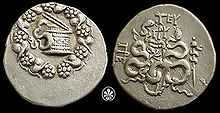Cista

A cista (kiste) in the classical world was generally a casket, used for example to hold unguents or jewels. More specifically, in the Mystery cult, a cista mystica (literally "sacred chest") is a basket or chest used to house snakes. Cistae mystica were used in the initiation ceremony of the cult of Bacchus or Dionysus, as well as an early gnostic sect called the Ophites. Cistae mysticae appear on ancient Roman and Greek coins.
Furthermore small Cistas were worked in Etruria, contained in cylindrical bronze containers for domestic use and storage of toiletries. Their faces were usually adorned engraved with figures, soldered on the top small bronze figures.
The Cista could be realised with different materials like wicker, wood, rawhide, but above of all in metal, used from the 5th century. The Etruscans manufactured it in different qualities from the 5th century, at first in ovoid form with thrown scenes, and then in cylindrical form with engraved scenes. The handle of the lid consisted of little structures. One of the most important city of production of Cista is Preneste, an old city of Lazio, which realised different types of Cista from the 4th century.
References
External links
- Cistae mysticae in numismatics
- Ophites
- Roman Republican Coins
- Coin with cista mystica
- Photo of coin from the British Museum